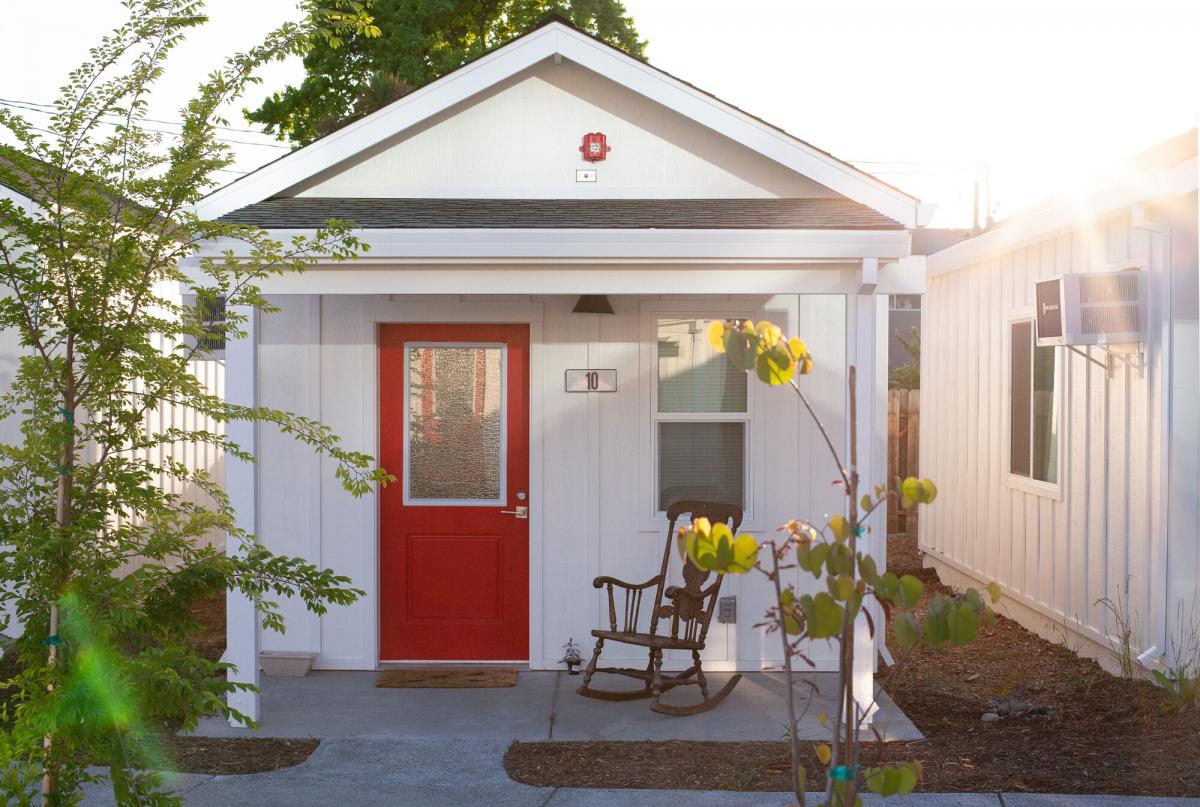From HUD USER, PD&R Edge, September 24, 2019

An hour north of San Francisco, Sonoma County is pursuing novel ways of addressing homelessness. One such effort is Veterans Village, a project that is currently in a two-year pilot phase in the city of Santa Rosa. The project, consisting of 14 tiny homes built on county-owned land, houses chronically homeless veterans who receive supportive services and rental assistance. At the heart of this project’s success, according to project developer Community Housing Sonoma County (CHSC), is its sense of community, cultivated through programmatic elements along with carefully considered site and building design. Built by CHSC with general contractor Wolff Contracting, Veterans Village demonstrates the potential benefits of applying innovative solutions to persistent social problems.
Rents in Sonoma County, as in much of California, have increased rapidly in recent years, fueled by a vacancy rate of approximately 1.5 percent. As a result, the county’s high rates of homelessness mirror those found in the rest of the state and are roughly three times the national average. The most recent Point-in-Time count for the county found 207 homeless veterans, 70 percent of whom were unsheltered. Recognizing the need for creative action, the county commissioned a study in 2015 to compile a diverse toolkit of strategies to help policymakers address homelessness from multiple angles. One of the strategies was to use tiny homes as permanent housing for homeless individuals in Sonoma County, with the report noting that despite modestly higher costs compared with multifamily buildings, tiny homes might be a more suitable option for individuals who may find denser group living a prohibitively stressful experience. After releasing a request for proposals in 2016, the county selected Veterans Village from among the half-dozen submissions as the winning bid.
Designed for community
Veterans Village was constructed on a portion of the Sonoma County administrative campus, which eliminated the cost burden of land acquisition. The 14 fully furnished units are arranged along gently curving paths encircling a garden. The arrangement promotes a sense of community, with views of neighboring homes from each unit, while still ensuring that residents maintain a sense of privacy and a space of their own. Each unit also has a small front porch to further mediate between public and private spaces. Units are 250 square feet and are fully accessible because many residents are coping with significant medical issues. Accessible features include roll-in showers and adaptable kitchen sinks as well as a site plan that eschews stairs. Exposed gabled ceilings in the units add a sense of height, and features such as sliding bathroom doors add a feeling of modern design quality. An additional building on the site provides a small community room and houses the mailroom and laundry facilities.
Two resident peer house managers (veterans who formerly experienced homelessness and are CHSC employees) perform important community-building functions at Veterans Village, including making weekly runs to the local food bank. The house managers orchestrate food pickups for residents in the community room and serve as leaders and mentors. All these features, according to Paula Cook, executive director of CHSC, demonstrate that thoughtful, community-oriented design and programming can add meaningfully to the success of a project that provides homes, not merely housing. As Cook put it, “It doesn’t feel like just a place to live.”

A single source of public funding supported development, with $1.9 million coming from the Sonoma County Community Development Commission’s County Fund for Housing. Cook stressed the critical importance of additional fundraising activity, especially the donated time and labor from Wolff Contracting, owned by Marine veteran Michael Wolff. Cook describes the efforts of Wolff Contracting, which took the unusual step of working through the rainy winter season to expedite the onsite building construction, as a labor of love. The company’s work helped ensure that Veterans Village could open in February 2019, housing people during the area’s most inhospitable season. Intake is conducted by the local Veterans Affairs medical clinic and residents must meet the eligibility requirements of the HUD-Veterans Affairs Supportive Housing program, which provides funding for case management as well as rental support.
As a pilot project, Veterans Village is demonstrating how alternative models of housing can offer their own particular strengths. Although Cook acknowledges that a tiny home development such as Veterans Village may not be the densest way to build, “from a therapeutic perspective, it’s ideal.” The project’s initial status as a two-year pilot was crucial to its development because it allowed the project to take advantage of an exception to the normal review requirements of the California Environmental Quality Act. Although Veterans Village may need to be relocated at the conclusion of the pilot phase in 2021, it is treated as permanent housing. Should the structures eventually be relocated, all current residents will continue to have their housing needs met by CHSC. In the meantime, the project will continue to encourage community among veterans as an important component in the larger effort to counter homelessness in Sonoma County.

